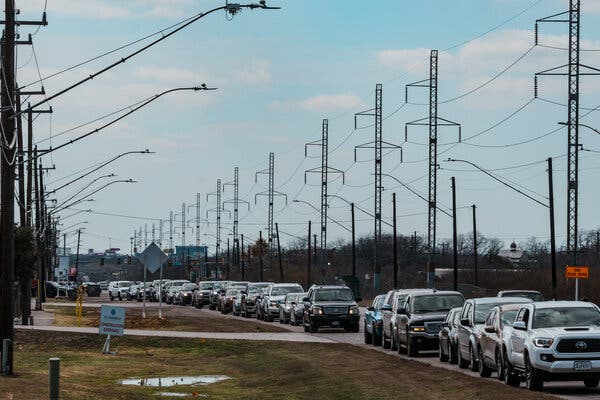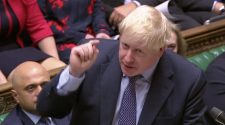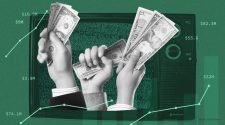Here’s what you need to know:

The company gave no reason for Mr. Bell’s departure in its announcement on Tuesday, but noted it would look for a successor “with the capabilities and qualifications to help accelerate GameStop’s transformation.” Mr. Bell joined GameStop less than two years ago.
GameStop jumped into the headlines in late January when amateur investors used trading apps to buy options and pump up its share price, defying hedge funds that had bet the price would fall. The chaotic trading led to congressional hearings last week, but executives from GameStop, which was essentially caught in the middle, were not called to testify.
GameStop’s share price closed at about $45 on Tuesday. It reached $483 on Jan. 28 after starting the year at $19.
The wild swings in share price were detached from what was happening at the company, where a major stockholder has been trying to force a turnaround. In early January, Ryan Cohen, the manager of RC Ventures and a large stockholder, joined the GameStop board. He has been pressuring the company’s executive team to overhaul GameStop’s strategy and focus on digital growth. The company has more than 5,000 stores, many in American malls and shopping strips, but has steadily lost sales to major online retailers like Amazon.
Mr. Bell joined the company in June 2019 at the age of 51 from Wok Holdings, which owns the restaurant chain P.F. Chang’s. In a short statement, GameStop thanked Mr. Bell “for his significant contributions and leadership, including his efforts over the past year during the Covid-19 pandemic.”

Fry’s Electronics, a big-box retailer on the West Coast, announced on Wednesday that it was shutting down operations, effective immediately.
The company, which is based in San Jose, Calif., replaced the contents of its website with a statement that said it had ceased operations and had begun the winding-down process. The retailer blamed the shutdown on “changes in the retail industry and the challenges posed by the Covid-19 pandemic.”
“It is hoped that undertaking the wind-down through this orderly process will reduce costs, avoid additional liabilities, minimize the impact on our customers, vendors, landlords and associates, and maximize the value of the company’s assets for its creditors and other stakeholders,” the statement said.
Fry’s has 31 stores across nine states and has been in business for nearly 36 years, according to the statement.
Stocks on Wall Street drifted lower on Wednesday as yields on government bonds continued to tick higher, signaling that investors continue to see fast economic growth and inflation ahead.
The S&P 500 index reached record highs earlier in the month as traders bet on the recovery and a successful vaccine rollout. Easy-money policies has also helped push asset prices higher. But fears that stronger economic growth and higher inflation would prompt the Fed to withdraw some monetary support have caused bond prices to fall, pushing up yields. This temporarily unsettled stock markets.
On Wednesday, yields on U.S. bonds resumed their march higher. The yield on 10-year notes jumped to as high as 1.42 percent. The S&P 500 was slightly lower in early trading.
Investors will be watching the Federal Reserve chief’s second day of testimony on Capitol Hill. On Tuesday, he reiterated the need to provide plenty of support for the economic recovery from the pandemic.
“The economic recovery remains uneven and far from complete, and the path ahead is highly uncertain,” Jerome Powell, the Fed chair, told the Senate Banking Committee on Tuesday. He will speak to lawmakers in the House on Wednesday.
Europe and Asia
-
Most European stocks indexes gained and the Stoxx Europe 600 rose 0.3 percent. The fourth quarter growth of Germany’s economy was revised higher to 0.3 percent, from 0.1 percent.
-
Most Asian indexes fell. The Hang Seng in Hong Kong dropped 3 percent with financial and consumer stocks falling the most after the government announced a plan to increase a tax on stock trading. Shares in Hong Kong Exchanges & Clearing fell by nearly 9 percent, the most in the index.
Commodities
-
Futures of West Texas Intermediate, the U.S. benchmark, rose more than 1 percent to $62 a barrel, the highest in 13 months. This week, for the first time since 2011, copper prices climbed above $9,000 a metric ton in London.

A winter storm in Texas that pushed its power grid to the brink of collapse and left millions without electricity during a brutal cold snap has led to the resignations of five officials who oversaw the state’s electric grid.
The Electric Reliability Council of Texas, which governs the flow of power for more than 26 million Texans, has been blamed for the widespread failures. The governor, lawmakers and federal officials quickly began inquiries into the system’s failures, particularly its preparation for cold weather, reports Rick Rojas for The New York Times.
The five board members, who announced on Tuesday that they intended to resign after a meeting set for Wednesday morning, were all from outside of Texas, a point of contention for critics who questioned the wisdom of outsiders playing such an influential role in the state’s infrastructure. In a statement filed with the Public Utility Commission, four board members said they were stepping down “to allow state leaders a free hand with future direction and to eliminate distractions.” In a footnote, the filing added that a fifth member was also resigning.
Those departing are the chairwoman, Sally Talberg, a former state utility regulator who lives in Michigan; Peter Cramton, the vice chairman and an economics professor at the University of Cologne in Germany and the University of Maryland; Terry Bulger, a retired banking executive who lives in Illinois; and Raymond Hepper, who is a former official with the agency overseeing the power grid in New England. Another person who was supposed to fill a vacant seat, Craig S. Ivey, has withdrawn from the 16-member board.
The board became the target of blame and scrutiny after the winter storm last week brought the state’s electric grid precariously close to a complete blackout that could have taken months to recover from. In a last-minute effort to avert that, the council, known as ERCOT, ordered rolling outages that plunged much of the state into darkness and caused electricity prices to skyrocket. Some customers had bills well over $10,000.
The second and final day of the DealBook DC Policy Project featured discussions on the prospects of bipartisan deal-making in Washington, overhauling of the financial markets and corporate America’s role in fighting the pandemic.
Here are the highlights from the sessions on Tuesday:
“We’ll lose 1.3 million jobs.”
Elements of Democrats’ stimulus proposals, including raising the federal minimum wage to $15 an hour, attracted criticism from Senator Mitt Romney, Republican of Utah. But he mentioned potential common ground with the Biden administration, including on climate change. Mr. Romney defended his traditional conservatism amid the G.O.P.’s embrace of right-wing populism, but noted that if former President Donald J. Trump ran for re-election in 2024, “I’m pretty sure he will win the nomination.”
“I think it’s pathological that you could have greater than 100 percent short interest.”
Lessons from meme-stock mania were among the topics discussed by Vlad Tenev, the chief executive of the online brokerage firm Robinhood. He defended the practice of directing trades to market makers for a fee, which allows Robinhood to offer commission-free trading. Also on the panel, Jay Clayton, the former chairman of the Securities and Exchange Commission, said that the markets were functioning the way they should in many ways, including by promoting competition among brokers and market makers.
“There will continue to be vaccinations required for Covid.”
The chief executive of CVS Health, Karen S. Lynch, spoke about the fight against the pandemic, saying that people would probably need booster shots and might need to keep wearing masks next year. But whether businesses should require employees to be inoculated was a “company-by-company response,” she said.

During two enormous crises — a public health emergency and an economic crash — restaurant service workers have found themselves double-exposed.
Many say their average tips have declined, while they’ve been saddled with the added work of policing patrons who aren’t social distancing, or as one service worker put it, “babysitting for the greater good,” Emma Goldberg reports for The New York Times.
On top of this, women, who make up more than two-thirds of servers, say they are facing “maskual harassment” — a term coined by the nonprofit organization One Fair Wage to describe demands that servers remove their masks to receive a tip.
The economic challenges have raised existential questions: Could this crisis herald the end of tipping, or a raise in the minimum wage for tipped workers? Depending on subjective gratuities has long been a fraught issue, but rarely has it had the safety consequences that it does now, when workers are struggling to enforce public health compliance from the customers whose tips they depend on.
Natasha Van Duser, 27, who tended bar in Manhattan, had never thought to show up to work with pepper spray. That was before last spring, when, she said, a customer dining outside spat on her and threatened to kill her when she asked him to put on a mask before walking to the bathroom; there were others who shouted expletives at her or suggested she take the temperature of their behinds instead of their foreheads.
In a recent national study of more than 1,600 workers, conducted by One Fair Wage and the Food Labor Research Center at the University of California, Berkeley, over three-quarters of workers reported “witnessing hostile behavior” from customers who were asked to comply with coronavirus protocols, more than 40 percent reported a change in the frequency of unwanted sexual comments during the pandemic and more than 80 percent reported that their tips had declined.

Boredom’s impact on the economy is under-researched, experts say, possibly because there has been no modern situation like this one, but many agree that it’s an important one, Sydney Ember reports for The New York Times.
Feeling bored may result in different kinds of behaviors, like increasing novelty seeking and increasing reward sensitivity, said Erin Westgate, an assistant professor of psychology at the University of Florida, who studies boredom.
This swirl of reactions to boredom can help explain the GameStop phenomenon, Ms. Westgate said. Investing in the stock was not just an act that felt engaging, powered by a propensity for taking risks and the excitement of reward, but also something that felt meaningful: For many traders, it was a form of protest.
Early in the pandemic, bread-making fervor prompted stores across the country to sell out of yeast. Puzzle sales have skyrocketed. Gardening has taken off as a hobby. Home improvement, too, has boomed. Sherwin-Williams said it had record sales in the fourth quarter and for the year, in part because of strong performances in its do-it-yourself and residential repaint businesses. Pandemic boredom evidently has nothing on watching paint dry.
There has also been an increase in sales of things like video games to keep us occupied, as well as things to help relieve the stress of the pandemic (and, perhaps, boredom from being at home), including self-help books, candles and messaging appliances.
It is possible that not being bored during certain periods of the day is also making people less productive, said Bec Weeks, who worked as a senior adviser for the Behavioural Economics Team of the Australian government and is a co-founder of a behavioral science app called Pique.
Research has shown that mind-wandering, an activity that can happen during periods of boredom, can result in greater productivity. But during the pandemic, some of the best opportunities for mind-wandering, like the daily commute to work, have been lost for the millions of people now working from home.
“Even in those moments when we used to be bored, there were often a lot of things going on that we didn’t realize,” Ms. Weeks said.

Last month, Laurence D. Fink, BlackRock’s chief executive, wrote that the company wanted businesses it invests in to remove as much carbon dioxide from the environment as they emit by 2050 at the latest.
But crucial details were missing from the pledge, including what proportion of the companies BlackRock invests in will be zero-emission businesses in 2050. On Saturday, in response to questions from The New York Times, a BlackRock spokesman said that the company’s “ambition” was to have “net zero emissions across our entire assets under management by 2050,” The New York Times’s Peter Eavis and Clifford Krauss report.
As the biggest companies strive to trumpet their environmental activism, the need to match words with deeds is becoming increasingly important.
Household names like Costco and Netflix have not provided emissions reduction targets. Others, like the agricultural giant Cargill and the clothing company Levi Strauss, have struggled to cut emissions. Technology companies like Google and Microsoft, which run power-hungry data centers, have slashed emissions, but are finding that the technology often doesn’t exist to carry out their “moonshot” objectives.
Determining how hard companies are really trying can be very difficult when there are no regulatory standards that require uniform disclosures of important information like emissions.
Institutional Shareholder Services, a firm that advises investors on how to vote on corporate matters, analyzed what corporations are doing to reduce emissions. Just over a third of the 500 companies in the S&P 500 stock index have set ambitious targets, it found, while 215 had no target at all. The rest had weak targets.
“To realize the necessary emission reductions, more ambitious targets urgently need to be set,” said Viola Lutz, deputy head of ISS ESG Climate Solutions, an arm of Institutional Shareholder Services. “Otherwise, we project emissions for S&P 500 companies will end up being triple of what they should be in 2050.”
The U.S. Postal Service on Tuesday chose Oshkosh Defense, a manufacturer of military vehicles, to build the next generation of postal delivery trucks, shunning an all-electric vehicle maker that had been in the running for the multibillion-dollar, 10-year contract.
Under an initial $482 million deal, Oshkosh will complete the design and then assemble 50,000 to 165,000 vehicles over 10 years, the Postal Service said.
Oshkosh was awarded the contract over two other bidders. One, the Workhorse Group, a small producer of electric delivery trucks based in Loveland, Ohio, was counting on the postal contract to provide a surge in revenue. At its height this month, the company’s stock was up more than tenfold in a year, in part on hopes it would win all or part of the postal contract. On Tuesday, after the Postal Service announced its decision, Workhorse shares lost nearly half their value. The other final bidder was Karsan, a Turkish maker of trucks and buses that was considered a long shot for the contract.
The choice of Oshkosh, which has no track record in producing electric vehicles, over Workhorse raised questions among some environmentalists over President Biden’s promised push to electrify the federal fleet. But some critics had also raised concerns that too swift a transition to plug-in trucks made by a fledgling company — and the buildup of charging infrastructure that would require — could burden a Postal Service already struggling with delivery delays.
Oshkosh has promised to shift to battery-powered vehicles if necessary, reflecting a wider push by automakers to bolster their offerings of electric vehicles to cut down on the industry’s carbon footprint. The new vehicles will be equipped with either fuel-efficient gasoline engines or electric batteries, and they will be retrofitted to keep pace with advances in electric vehicle technology, the Postal Service said.
The Post Office operates almost 230,000 vehicles and has one of the world’s largest civilian vehicle fleets, but its aging fleet — which federal data shows gets only about 10 miles a gallon — had also long been due for an upgrade.


















